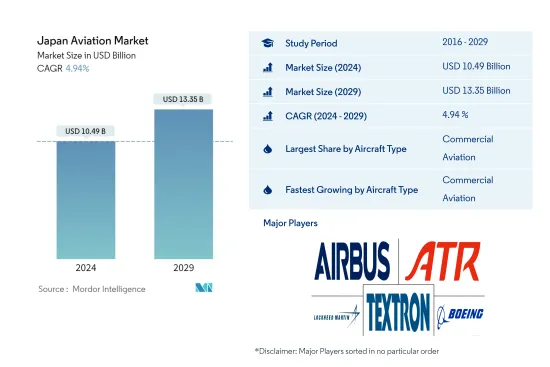Need help finding what you are looking for?
Contact Us
PUBLISHER: Mordor Intelligence | PRODUCT CODE: 1441444

PUBLISHER: Mordor Intelligence | PRODUCT CODE: 1441444
Japan Aviation - Market Share Analysis, Industry Trends & Statistics, Growth Forecasts (2024 - 2029)
PUBLISHED:
PAGES: 80 Pages
DELIVERY TIME: 2-3 business days
SELECT AN OPTION
The Japan Aviation Market size is estimated at USD 10.49 billion in 2024, and is expected to reach USD 13.35 billion by 2029, growing at a CAGR of 4.94% during the forecast period (2024-2029).

Key Highlights
- Largest Market by Aircraft Type - Commercial Aviation : Increasing air passenger traffic and its recovery to pre-pandemic levels, coupled with replacing existing aircraft with advanced sustainable aircraft, is driving the commercial aviation market.
- Largest Market by Sub-Aircraft Type - Passenger Aircraft : Increasing the international reach of the country's airlines to match ongoing passenger traffic is anticipated to drive the market from 2022 to 2028.
Japan Aviation Market Trends
Commercial Aviation is the largest Aircraft Type
- The commercial aviation industry, comprising airlines and their supply chains, is estimated to contribute USD 72.1 billion to Japan's GDP during the forecast period. In all, inputs to the air transport sector and foreign tourists coming by air support 2.4% of the country's GDP.
- Japan is one of the world's strongly growing commercial aviation markets, despite the COVID-19 epidemic impacting the region's commercial airline industry. The recovery of passenger traffic is anticipated to aid in the revival of Japan's commercial aviation industry. Japan witnessed a total increase of 139% in Air Passenger traffic in 2021. The rise in passenger traffic is due to ease in border restrictions.
- Factors such as the increasing rate of HNWIs, training schools, the government's focus on developing business jet infrastructure, and deregulation activities are expected to drive the growth of general aviation in Japan during the forecast period.
- Charter operators in the country are constantly expanding their routes and are adding new aircraft to their fleets, driven by the growing need for non-scheduled business travel. This has helped the demand for business jets and turboprops in Japan. On the other hand, the demand for light sport and trainer aircraft remained high, contributing to the general aviation fleet growth.
- Japan's Defense Ministry proposed a budget for fiscal 2022 of more than USD 49.3 billion at the beginning of 2021, which is a record and potentially exceeds the long-standing cap of 1% of GDP. By 2027, Japan might be the world's third-largest defense spender, after only the United States and China.
Japan Aviation Industry Overview
The Japan Aviation Market is fairly consolidated, with the top five companies occupying 96.59%. The major players in this market are Airbus SE, ATR, Lockheed Martin Corporation, Textron Inc. and The Boeing Company (sorted alphabetically).
Additional Benefits:
- The market estimate (ME) sheet in Excel format
- 3 months of analyst support
Product Code: 92659
TABLE OF CONTENTS
1 EXECUTIVE SUMMARY & KEY FINDINGS
2 REPORT OFFERS
3 INTRODUCTION
- 3.1 Study Assumptions & Market Definition
- 3.2 Scope of the Study
- 3.3 Research Methodology
4 KEY INDUSTRY TRENDS
- 4.1 Air Passenger Traffic
- 4.2 Air Transport Freight
- 4.3 Gross Domestic Product
- 4.4 Revenue Passenger Kilometers (RPK)
- 4.5 Inflation Rate
- 4.6 Active Fleet Data
- 4.7 Defense Spending
- 4.8 High-Net-Worth Individual (HNWI)
- 4.9 Regulatory Framework
- 4.10 Value Chain Analysis
5 MARKET SEGMENTATION
- 5.1 Aircraft Type
- 5.1.1 Commercial Aviation
- 5.1.1.1 By Sub Aircraft Type
- 5.1.1.1.1 Freighter Aircraft
- 5.1.1.1.2 Passenger Aircraft
- 5.1.1.1.2.1 By Body Type
- 5.1.1.1.2.1.1 Narrowbody Aircraft
- 5.1.1.1.2.1.2 Widebody Aircraft
- 5.1.2 General Aviation
- 5.1.2.1 By Sub Aircraft Type
- 5.1.2.1.1 Business Jets
- 5.1.2.1.1.1 By Body Type
- 5.1.2.1.1.1.1 Large Jet
- 5.1.2.1.1.1.2 Light Jet
- 5.1.2.1.1.1.3 Mid-Size Jet
- 5.1.2.1.2 Piston Fixed-Wing Aircraft
- 5.1.2.1.3 Others
- 5.1.3 Military Aviation
- 5.1.3.1 By Sub Aircraft Type
- 5.1.3.1.1 Fixed-Wing Aircraft
- 5.1.3.1.1.1 By Body Type
- 5.1.3.1.1.1.1 Multi-Role Aircraft
- 5.1.3.1.1.1.2 Training Aircraft
- 5.1.3.1.1.1.3 Transport Aircraft
- 5.1.3.1.1.1.4 Others
- 5.1.3.1.2 Rotorcraft
- 5.1.3.1.2.1 By Body Type
- 5.1.3.1.2.1.1 Multi-Mission Helicopter
- 5.1.3.1.2.1.2 Transport Helicopter
- 5.1.3.1.2.1.3 Others
- 5.1.1 Commercial Aviation
6 COMPETITIVE LANDSCAPE
- 6.1 Key Strategic Moves
- 6.2 Market Share Analysis
- 6.3 Company Landscape
- 6.4 Company Profiles
- 6.4.1 Airbus SE
- 6.4.2 ATR
- 6.4.3 Bombardier Inc.
- 6.4.4 Kawasaki Heavy Industries, Ltd.
- 6.4.5 Lockheed Martin Corporation
- 6.4.6 Textron Inc.
- 6.4.7 The Boeing Company
7 KEY STRATEGIC QUESTIONS FOR AVIATION CEOS
8 APPENDIX
- 8.1 Global Overview
- 8.1.1 Overview
- 8.1.2 Porter's Five Forces Framework
- 8.1.3 Global Value Chain Analysis
- 8.1.4 Market Dynamics (DROs)
- 8.2 Sources & References
- 8.3 List of Tables & Figures
- 8.4 Primary Insights
- 8.5 Data Pack
- 8.6 Glossary of Terms
Have a question?


SELECT AN OPTION
Have a question?


Questions? Please give us a call or visit the contact form.
